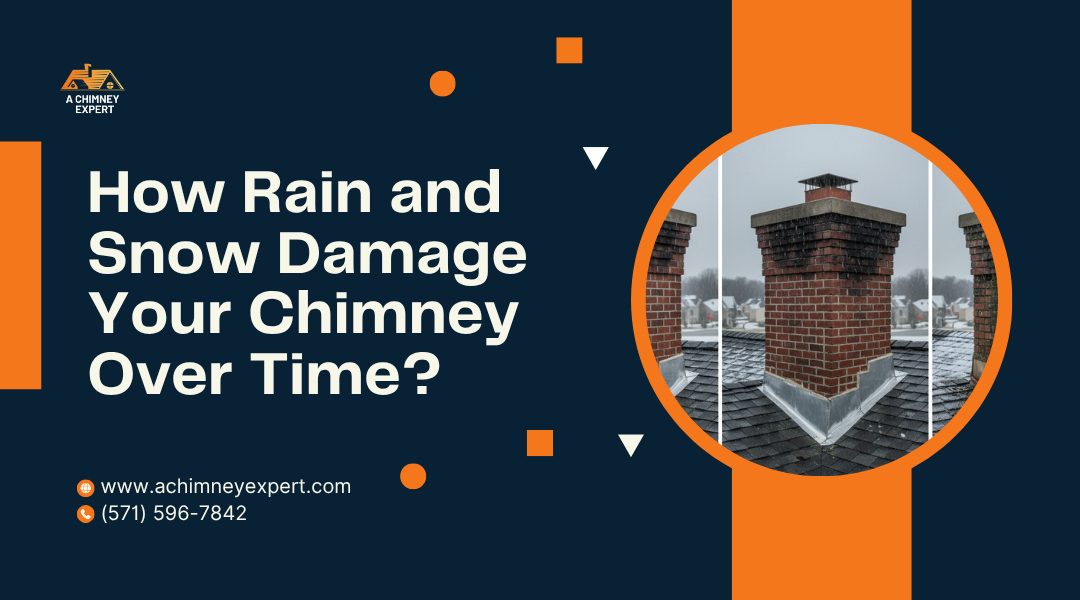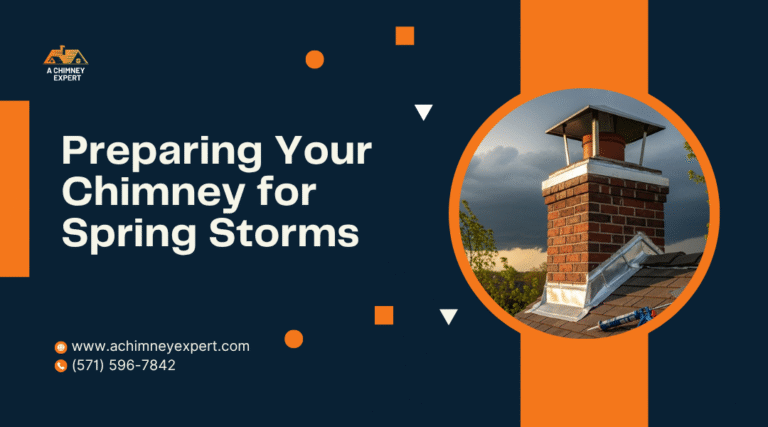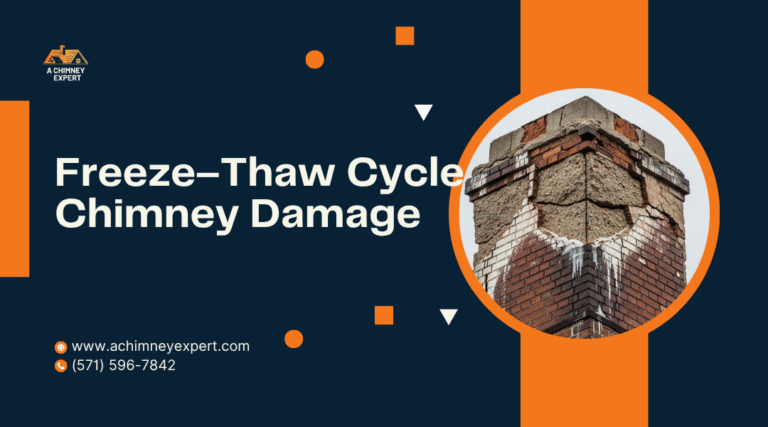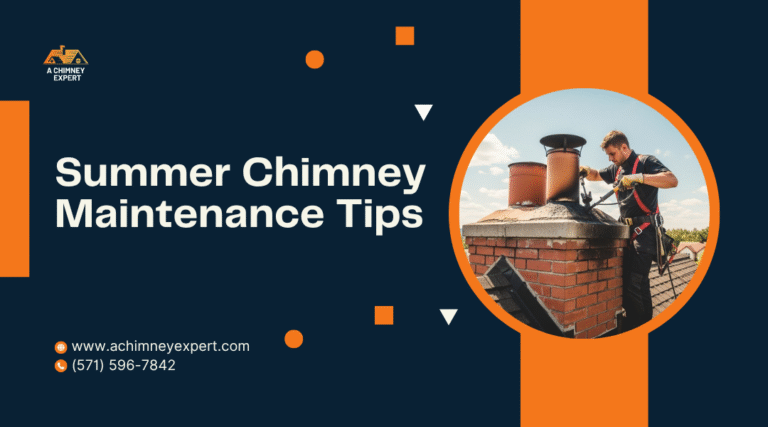Your chimney faces a constant battle against rain and snow throughout the year. These two weather elements work together to slowly break down your chimney’s structure through a process that happens gradually but causes serious damage over time.
Rain seeps into bricks and mortar, then freezes during cold weather, causing the moisture to expand and crack the masonry in what experts call the freeze-thaw cycle. This process weakens your chimney’s foundation and can lead to costly repairs or even structural collapse if you ignore the warning signs. Snow adds extra weight and pressure while creating more opportunities for water to penetrate your chimney’s defenses.
Understanding how these weather patterns damage your chimney helps you spot problems early and take steps to protect your investment. You’ll learn about the specific ways moisture harms your chimney, the warning signs to watch for, and proven methods to shield your chimney from Oak Grove’s changing weather conditions.
How Weather Affects Your Chimney
Weather conditions create constant stress on your chimney’s structure through moisture infiltration, temperature changes, and material expansion. Virginia’s humid climate and freeze-thaw cycles accelerate masonry breakdown and create pathways for water damage.
The Role of Moisture in Masonry Deterioration
Water acts as the primary enemy of chimney masonry systems. When moisture seeps into brick and mortar joints, it weakens the binding materials that hold your chimney together.
Freeze-thaw cycles cause the most severe damage. Water expands by 9% when it freezes, creating tremendous pressure inside masonry pores.
This expansion forces cracks to widen with each freeze. Over time, small hairline cracks become major structural problems.
Your chimney experiences this cycle repeatedly during winter months. Each freeze creates more damage than the last.
Common moisture damage includes:
- Spalling bricks (surface flaking)
- Crumbling mortar joints
- White staining (efflorescence)
- Interior water leaks
The deterioration process accelerates once water finds entry points. Damaged areas allow more moisture penetration, creating a destructive cycle.
Why Virginia’s Climate Poses Unique Challenges for Chimney Health
Virginia’s climate creates perfect conditions for chimney deterioration. The state experiences high humidity levels throughout summer months.
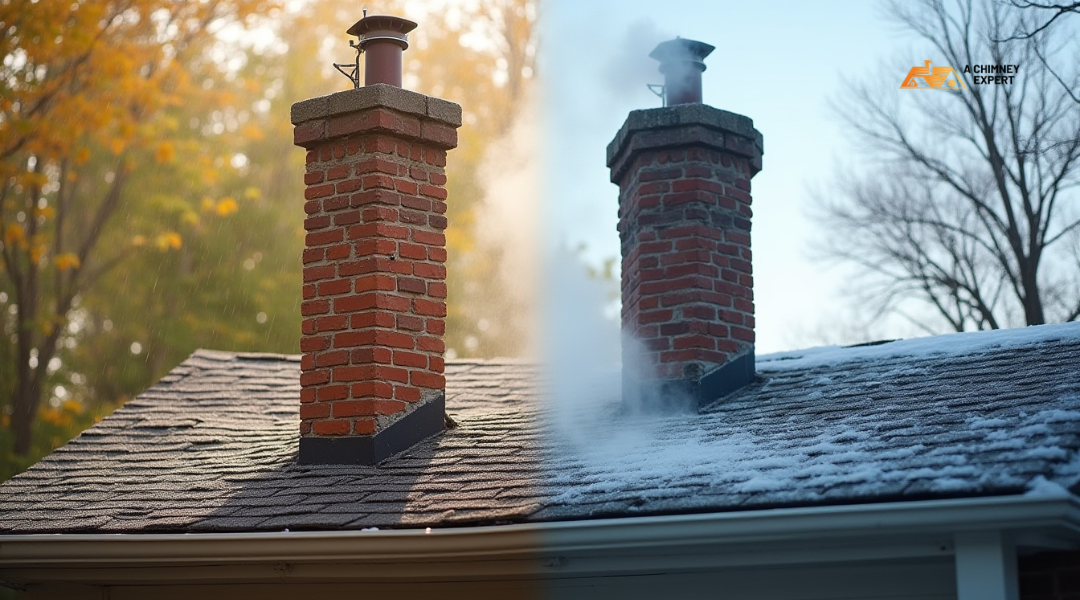
Temperature fluctuations stress masonry materials constantly. Your chimney expands during hot days and contracts during cool nights.
Winter brings frequent freeze-thaw cycles. Temperatures often hover around the freezing point, creating repeated ice formation and melting.
Virginia weather patterns include:
- High summer humidity (60-80%)
- Frequent temperature swings
- Heavy spring rainfall
- Ice storms in winter
The combination of moisture and temperature changes accelerates material breakdown. Your chimney faces these stresses year-round without relief.
Coastal areas experience additional salt exposure. Salt crystals form inside masonry and expand, causing internal pressure damage.
The Hidden Risks of Water Penetration in Chimney Systems
Water penetration creates problems beyond visible masonry damage. Once moisture enters your chimney system, it affects multiple components simultaneously.
Interior damage often goes unnoticed until major problems develop. Water travels through masonry and damages wooden structural elements.
Your home’s framing members can rot when exposed to chimney leaks. This creates expensive structural repairs beyond chimney work.
Water penetration causes:
- Mold growth in wall cavities
- Ceiling and wall stains
- Damaged insulation
- Electrical system risks
Metal components deteriorate rapidly when exposed to moisture. Dampers, fireboxes, and flue liners develop rust and corrosion.
The chimney crown acts as your first defense against water entry. Cracks in the crown allow direct water access to the entire system.
Without proper waterproofing, your chimney becomes a pathway for water into your home’s structure.
How Rain Damages Your Chimney Over Time
Rain water enters your chimney through tiny cracks and weak spots, causing damage that gets worse each year. The water breaks down mortar, rusts metal parts, and creates moisture problems that affect your home’s air quality.
Erosion of Mortar Joints and Brickwork
Water soaks into the mortar between your bricks through small cracks and holes. When temperatures drop, this water freezes and expands.
The freeze-thaw cycle pushes against the mortar from the inside. This creates bigger cracks each time it happens.
Common signs of mortar damage:
- White stains on bricks (efflorescence)
- Crumbling mortar between bricks
- Loose or missing pieces of mortar
- Bricks that feel loose when touched
Your brickwork also suffers when water gets inside. Old bricks become soft and crumbly after years of water damage.
The mortar joints fail first because they are softer than the bricks. Once the mortar weakens, more water enters your chimney system.
Rain damage happens faster on chimneys that face the direction of heavy storms. The constant water hitting the same spots creates weak areas.
Rust and Corrosion in Metal Components (Flue, Cap, and Damper)
Metal parts in your chimney rust when they stay wet for long periods. Your damper, flue liner, and chimney cap are most at risk.
The damper sits at the bottom of your flue and gets hit by water from above. Rust makes it hard to open and close properly.
A rusty damper can stick in the open position. This lets rain pour directly into your fireplace and home.
Metal components that rust from rain:
- Steel flue liners
- Cast iron dampers
- Metal chimney caps
- Steel fireplace grates
Your flue liner protects the chimney walls from heat and moisture. When it rusts through, dangerous gases can leak into your home.
Chimney caps made of cheap metal rust quickly in wet weather. The rust creates holes that let even more water inside.
Replacing rusted metal components costs much more than preventing the damage. Regular inspections help catch rust problems early.
Moisture Inside the Flue: Odor, Mold, and Smoke Issues
Water that enters your flue creates a damp environment perfect for mold growth. The moisture mixes with old soot and ash to create strong odors.
These smells get stronger in humid weather and can fill your living room. The odors come from bacteria breaking down the wet organic matter.
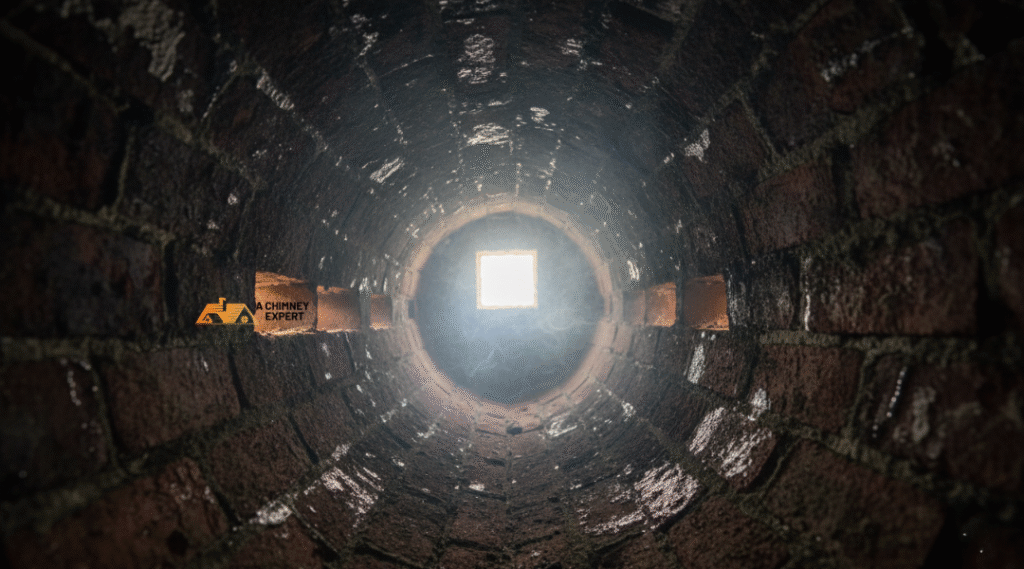
Mold grows on the inside walls of wet chimneys. Some types of mold create health problems for your family.
Problems from moisture in your flue:
- Musty smells that enter your home
- Black or green mold on chimney walls
- White staining on the outside of your chimney
- Poor draft that pushes smoke into your room
Wet chimneys don’t draw smoke properly. The moisture cools the air inside the flue and reduces the natural draft.
Water also damages the smoke shelf and smoke chamber. These areas collect moisture and develop structural problems over time.
How Poor Flashing or a Missing Cap Makes Rain Damage Worse
Flashing seals the gap between your roof and chimney. When it fails, large amounts of water pour into the chimney structure.
Poor flashing lets water run down inside your chimney walls. This creates damage that is hard to see until it becomes serious.
A missing or damaged chimney cap turns your flue into a funnel for rainwater. The water hits your damper and flows down into your fireplace.
Signs your flashing needs repair:
- Water stains on walls near the chimney
- Loose or bent flashing around the base
- Missing caulk or sealant
- Rust spots on metal flashing
Step flashing should go under your roof shingles and over the chimney. Many roofers install it wrong, which causes leaks later.
Your chimney cap should have a good overhang to keep rain away from the flue opening. Caps that are too small don’t protect well enough.
Without proper protection, rain damage happens much faster. A good cap and flashing system can add many years to your chimney’s life.
How Snow and Ice Compounds the Problem
Snow and ice create repeated freeze-thaw cycles that crack masonry and metal components. Winter weather also forms ice dams that redirect water into vulnerable chimney areas, while freezing temperatures expand existing cracks into major structural issues.
Freeze–Thaw Cycles: The Silent Structural Destroyer
Water expands by approximately 9% when it freezes. This expansion creates tremendous pressure inside your chimney’s masonry joints and small cracks.
During winter months, snow melts during warmer days and seeps into tiny gaps in your chimney. When temperatures drop at night, this water freezes and expands.
The cycle works like this:
- Water enters small cracks in mortar joints
- Freezing temperatures cause water to expand
- Expansion widens the existing cracks
- Melting allows more water to enter deeper
Each freeze-thaw cycle makes existing damage worse. A hairline crack in your chimney crown can become a significant structural problem after just one winter season.
Your chimney’s brick and mortar are especially vulnerable. The constant expansion and contraction weakens the bonds between materials, creating loose bricks and crumbling mortar.
Ice Dams and Roof Runoff Around the Chimney
Ice dams form when snow melts on your warm roof and refreezes at the cold edges. This creates a barrier that traps melting water behind it.
Your chimney penetrates through your roof, creating natural weak points where water can enter. Ice dams force melting water to find alternative paths, often directing it toward your chimney’s base.
Common ice dam problems include:
- Water backing up under roof shingles near the chimney
- Overflow water pooling around chimney flashing
- Ice buildup that damages flashing seals
- Frozen gutters that redirect water toward chimney structures
The weight of ice dams also stresses your roof structure. Heavy ice can pull flashing away from your chimney, creating gaps where water easily enters your home.
Ice dams typically form on north-facing roof sections where your chimney creates shadows and prevents snow from melting evenly.
Cracks, Gaps, and Leaks Formed During Winter Months
Winter weather creates new entry points for water while making existing problems significantly worse. Metal flashing contracts in cold temperatures, pulling away from chimney surfaces.
Your chimney cap and crown develop stress cracks from repeated temperature changes. These cracks start small but grow larger each winter season.
Winter damage typically appears as:
- Spalling bricks – surface layers that flake off from freeze-thaw damage
- Open mortar joints – gaps between bricks that widen over time
- Crown cracks – splits in the concrete top of your chimney
- Flashing separation – metal seals that pull away from surfaces
Snow accumulation adds extra weight to already stressed chimney structures. Wet snow can weigh up to 20 pounds per cubic foot, putting additional pressure on damaged areas.
These winter-formed cracks become highways for water entry during spring rains. What starts as minor freeze damage becomes major water infiltration problems that affect your entire chimney system.
Signs Your Chimney Is Suffering from Moisture Damage
Water damage in chimneys shows clear warning signs that homeowners can spot early. These signs include white stains on bricks, crumbling surfaces, strange smells, and water marks inside your home.
Visible Efflorescence or White Staining
White chalky stains on your chimney bricks are called efflorescence. This happens when water moves through the masonry and leaves salt deposits behind.
You’ll see these white streaks or powdery patches on the outside of your chimney. They often appear after rain or snow.
Common locations for white staining:
- Brick surfaces
- Mortar joints
- Base of the chimney
- Areas without proper drainage
The white deposits mean water is getting into your chimney structure. This process weakens the bricks and mortar over time.
Fresh efflorescence looks bright white and powdery. Older stains may appear yellowish or gray.
Flaking Bricks or Spalling Surfaces
Spalling happens when the face of bricks starts to chip, flake, or fall off. Water gets into the brick, freezes, and expands.
This freeze-thaw cycle pushes pieces of brick away from the surface. You’ll see small chips or large chunks missing from your chimney bricks.
Signs of spalling damage:
- Brick pieces on the ground near your chimney
- Rough, pitted brick surfaces
- Missing chunks from brick faces
- Exposed inner brick material
Spalling gets worse during winter months. The damage spreads quickly once it starts.
New bricks that are spalling feel rough to the touch. Severely damaged bricks may crumble when you press on them.
Musty Odors or Smoke Backdraft
Moisture in your chimney creates musty, damp smells. These odors get stronger during humid weather or after rain.
The smell comes from water mixing with creosote buildup inside your chimney. This creates an unpleasant, sour odor.
You might also notice smoke coming back into your room instead of going up the chimney. Moisture can block airflow or damage the flue liner.
Odor warning signs:
- Musty smell from fireplace when not in use
- Stronger odors after rain
- Smoke entering your room during fires
- Damp smell in nearby rooms
These smells often mean water is getting into your chimney system. The problem usually gets worse over time without repairs.
Water Spots on Ceilings or Nearby Walls
Water stains on your ceiling or walls near the chimney show serious moisture problems. These brown or yellow spots mean water is leaking through your roof or chimney.
Look for stains in rooms next to your chimney. Check your attic for water marks on wood beams or insulation.
Areas to check for water damage:
- Ceiling around chimney base
- Walls touching the chimney
- Attic spaces near chimney
- Basement walls below chimney
Fresh water stains look dark brown or black. Older stains fade to yellow or light brown.
Water damage inside your home means the chimney’s protective systems have failed. This requires immediate professional attention to prevent mold and structural damage.
Long-Term Consequences of Ignoring Chimney Water Damage
When you ignore water damage in your chimney, the problems grow worse each year. These issues create dangerous safety risks, increase fire hazards, and lead to repair costs that can reach thousands of dollars.
Decline in Structural Integrity and Safety Hazards
Water damage weakens your chimney’s structure from the inside out. The freeze-thaw cycle causes trapped moisture to expand and crack your masonry each winter.
Your mortar joints become loose and crumble over time. The bricks start to shift and separate from each other. This damage makes your chimney unstable and dangerous.
Key structural problems include:
- Loose or falling bricks
- Cracked chimney crown
- Damaged flue liner
- Weakened foundation
Your chimney can lean or even collapse if the damage gets too severe. A falling chimney can destroy part of your roof and create a major safety risk for your family.
Water also causes metal components to rust and fail. Your damper, flashing, and chimney cap deteriorate quickly when exposed to constant moisture.
Increased Risk of Chimney Fires or Carbon Monoxide Leaks
Water damage creates serious fire and gas poisoning risks in your home. When your flue liner cracks from water damage, dangerous gases can leak into your living space.
Carbon monoxide is colorless and odorless. You won’t know it’s there until someone gets sick. Cracked chimney liners let this deadly gas seep through your walls and into your rooms.
Water damage also increases fire risks by:
- Creating gaps where heat can escape
- Allowing creosote buildup in damaged areas
- Weakening the chimney’s ability to contain fires
- Damaging the flue liner that protects your home
Your damaged chimney cannot safely remove smoke and gases from your fireplace. This poor ventilation creates backdrafts that push dangerous fumes into your home.
Costly Repairs That Could Have Been Prevented
Small water leaks turn into expensive repair projects when you ignore them. A simple $200 chimney cap replacement can prevent thousands in future damage.
Common repair costs from ignored water damage:
| Repair Type | Prevention Cost | Damage Repair Cost |
|---|---|---|
| Chimney Cap | $200-400 | $2,000-5,000 |
| Waterproofing | $300-600 | $3,000-8,000 |
| Minor Tuckpointing | $500-1,000 | $5,000-15,000 |
You might need to rebuild your entire chimney if water damage goes too far. Complete chimney reconstruction costs between $10,000 and $20,000.
Water damage also affects other parts of your home. Your roof, walls, and ceilings can suffer expensive damage when chimney leaks spread. Mold growth from persistent moisture creates health problems and costly cleanup.
Insurance companies often won’t cover damage from poor maintenance. You’ll pay these repair costs out of your own pocket when you ignore early warning signs.
How to Protect Your Chimney from Rain and Snow Damage
Regular professional inspections and proper waterproofing create the first line of defense against weather damage. Installing quality chimney caps and maintaining flashing prevents water entry while addressing small problems early stops costly repairs.
Annual Inspections by Certified Chimney Professionals
Schedule your chimney inspection every year before the heating season starts. Professional chimney sweeps can spot early signs of weather damage that you might miss.
During inspections, certified professionals check for cracks in the masonry and mortar joints. They also examine the chimney cap, flashing, and damper for wear or damage.
Key inspection areas include:
- Crown and cap condition
- Flashing around the chimney base
- Interior liner integrity
- Damper operation
- Masonry and mortar condition
Early detection saves money on repairs. Small cracks can turn into major structural problems if left untreated through multiple freeze-thaw cycles.
Professional inspections cost between $100-300 but prevent thousands in damage repairs. Many companies offer cleaning and inspection packages for better value.
Chimney Waterproofing and Masonry Sealants
Apply waterproof sealants to your chimney’s exterior masonry every 3-5 years. These products let moisture escape while blocking water from entering the brick and mortar.
Choose vapor-permeable sealants specifically made for chimneys. Regular paint or generic sealers can trap moisture inside the masonry and cause more damage.
Best waterproofing practices:
- Clean the chimney surface before applying sealant
- Apply during dry weather with temperatures above 50°F
- Use silane or siloxane-based products
- Avoid sealing damaged areas without repairs first
Quality sealants penetrate deep into the masonry pores. This creates a barrier that repels water while allowing trapped moisture to escape naturally.
Professional waterproofing typically lasts longer than DIY applications. Experts know which products work best for your specific masonry type and local weather conditions.
Installing or Replacing Chimney Caps and Flashing
Install a properly sized chimney cap with a spark arrestor and animal guards. The cap should cover the entire flue opening while allowing smoke to exit freely.
Chimney caps prevent rain and snow from entering directly down the flue. They also keep out animals, birds, and debris that can block airflow.
Essential cap features:
- Stainless steel or copper construction
- Proper overhang to shed water
- Mesh screening (3/4 inch maximum)
- Secure mounting to the crown
Check flashing around your chimney base twice yearly. This metal barrier seals the joint between your roof and chimney structure.
Replace damaged or loose flashing immediately. Poor flashing allows water to leak into your home’s structure and attic space.
Step flashing works best for most chimney installations. It consists of individual pieces that overlap like shingles to direct water away from the chimney base.
Timely Repairs to Prevent Small Issues from Spreading
Fix small cracks in mortar joints before they expand during freeze-thaw cycles. Water entering these cracks can cause significant structural damage over time.
Repoint damaged mortar joints with matching mortar mix. Remove loose or cracking mortar to a depth of at least one inch before applying new material.
Common repair priorities:
- Cracked chimney crown
- Loose or missing bricks
- Damaged mortar joints
- Rusted damper or firebox
- Deteriorated flue liner
Replace individual damaged bricks when you notice them. One damaged brick can allow water entry that affects surrounding masonry.
Address white staining on your chimney exterior immediately. This efflorescence indicates water is moving through the masonry and depositing mineral salts.
Schedule repairs during dry weather when materials can cure properly. Most masonry repairs need several days without rain or freezing temperatures to set correctly.
Why Homeowners in Oak Grove Trust A Chimney Expert LLC
A Chimney Expert LLC has built its reputation through decades of reliable service and specialized knowledge of local weather challenges. Their certified technicians use professional-grade tools and transparent pricing to deliver consistent results for Virginia homeowners.
Over 45 Years of Experience in Chimney Care and Safety
A Chimney Expert LLC brings more than four decades of hands-on experience to every job. This extensive background means they have seen and solved virtually every chimney problem that can occur in Virginia homes.
The company has worked through thousands of repairs, cleanings, and inspections. They understand how different chimney systems age and fail over time. This experience helps them spot problems early before they become expensive emergencies.
Key experience areas include:
- Masonry restoration and brick repair
- Flue liner replacement and repair
- Crown rebuilding and waterproofing
- Complex leak detection and resolution
Their long history in Oak Grove means they know the common issues that affect homes in your area. They have worked on chimneys built in different eras using various materials and construction methods.
CSIA-Certified Technicians and Advanced Inspection Tools
All technicians at A Chimney Expert LLC hold certifications from the Chimney Safety Institute of America (CSIA). This certification requires extensive training in chimney safety, construction, and repair techniques.
CSIA certification is not automatic. Technicians must pass rigorous exams covering fire safety, ventilation principles, and proper installation methods. They also complete ongoing education to stay current with industry standards.
The company uses professional inspection cameras to examine flue interiors. These cameras reveal cracks, blockages, and deterioration that cannot be seen from ground level. High-powered vacuum systems and specialized brushes ensure thorough cleaning.
Professional equipment includes:
- Digital inspection cameras
- Moisture meters for leak detection
- Industrial-grade vacuum systems
- Specialized masonry repair tools
This combination of certified knowledge and proper equipment ensures accurate diagnosis and effective repairs.
Local Expertise with Virginia’s Weather Conditions
Oak Grove’s climate presents specific challenges for chimney systems. The area experiences freeze-thaw cycles that crack masonry and heavy rains that test waterproofing systems.
A Chimney Expert LLC understands how Virginia weather affects different chimney materials. They know which sealants work best in your climate and how to prepare systems for seasonal changes.
The company has observed how local weather patterns cause specific types of damage. Winter ice formation, spring moisture, and summer humidity each create different maintenance needs.
They recommend timing for repairs and maintenance based on Oak Grove’s seasonal patterns. This local knowledge helps prevent weather-related damage before it starts.
Transparent Service, Honest Pricing, and Reliable Results
A Chimney Expert LLC provides detailed written estimates before starting any work. You receive clear explanations of what needs repair and why each service is necessary.
The company does not use high-pressure sales tactics or recommend unnecessary services. Their technicians explain problems clearly and offer multiple repair options when possible.
Service transparency includes:
- Written estimates with itemized costs
- Before and after photos of repairs
- Clear explanations of safety issues
- Warranties on completed work
Payment is not required until you are satisfied with the completed work. The company stands behind their repairs with solid warranties and responsive follow-up service.
Their scheduling system respects your time with reliable appointment windows. Emergency services are available when safety issues require immediate attention.

